Effective Teamwork and Communication: Strategies for Employers
VerifiedAdded on 2023/01/11
|8
|2623
|47
Report
AI Summary
This report explores the crucial role of effective teamwork and communication in organizational success. It begins by outlining various communication methods used by employers, such as weekly employee correspondence, addressing employee problems, town hall meetings, senior leadership conferences, and prompt email responses. The report then delves into Tuckman's model of team development, detailing the forming, storming, norming, performing, and adjourning stages, and emphasizes the importance of each stage for team performance. Furthermore, the report identifies key steps employers can take to improve workplace communication, including choosing the right communication medium, fostering interactivity, communicating with a clear purpose, avoiding generalizations, planning, dedicating time, and following up on communications. The report concludes that integrating these strategies is essential for achieving organizational goals and objectives, fostering efficiency, effectiveness, and productivity.
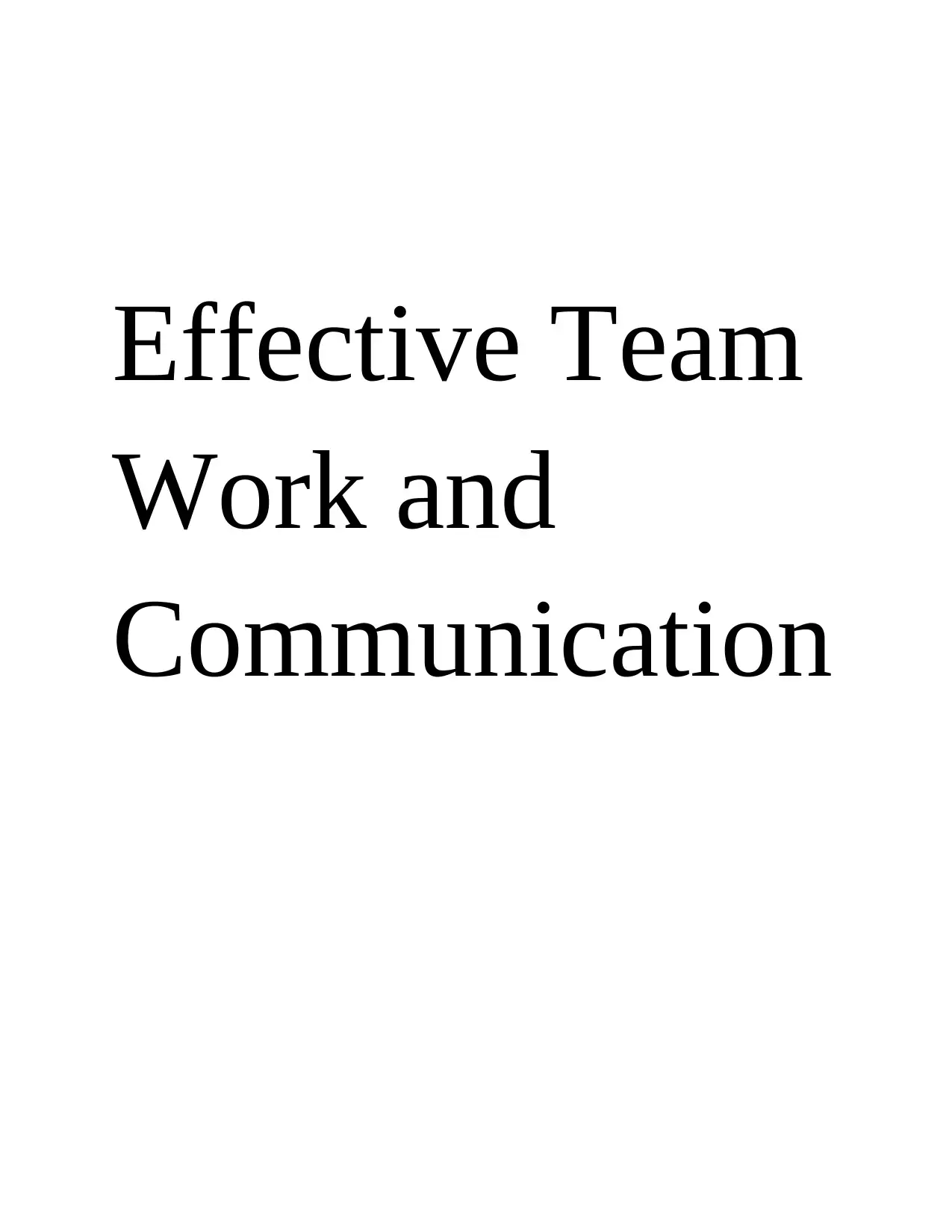
Effective Team
Work and
Communication
Work and
Communication
Paraphrase This Document
Need a fresh take? Get an instant paraphrase of this document with our AI Paraphraser
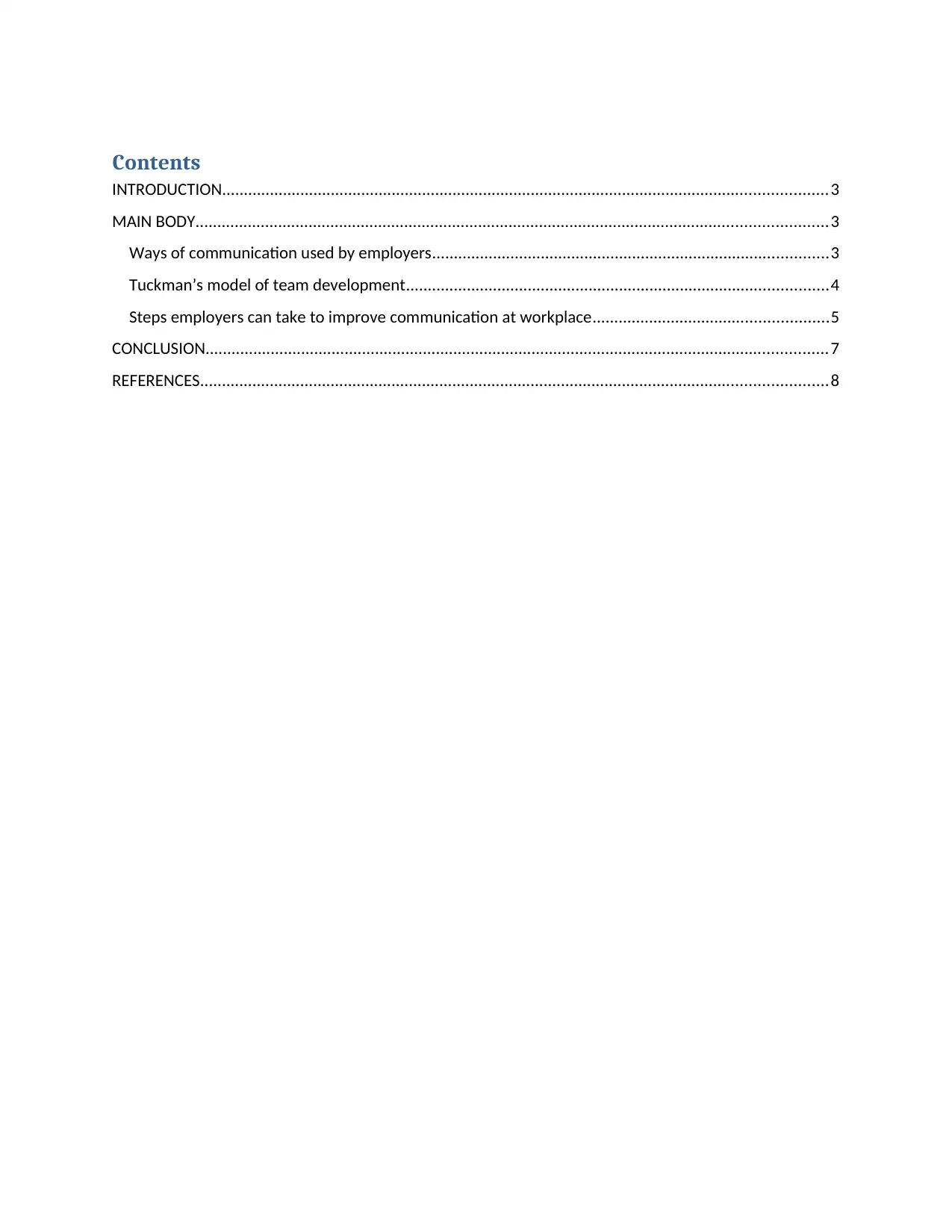
Contents
INTRODUCTION...........................................................................................................................................3
MAIN BODY.................................................................................................................................................3
Ways of communication used by employers...........................................................................................3
Tuckman’s model of team development.................................................................................................4
Steps employers can take to improve communication at workplace......................................................5
CONCLUSION...............................................................................................................................................7
REFERENCES................................................................................................................................................8
INTRODUCTION...........................................................................................................................................3
MAIN BODY.................................................................................................................................................3
Ways of communication used by employers...........................................................................................3
Tuckman’s model of team development.................................................................................................4
Steps employers can take to improve communication at workplace......................................................5
CONCLUSION...............................................................................................................................................7
REFERENCES................................................................................................................................................8
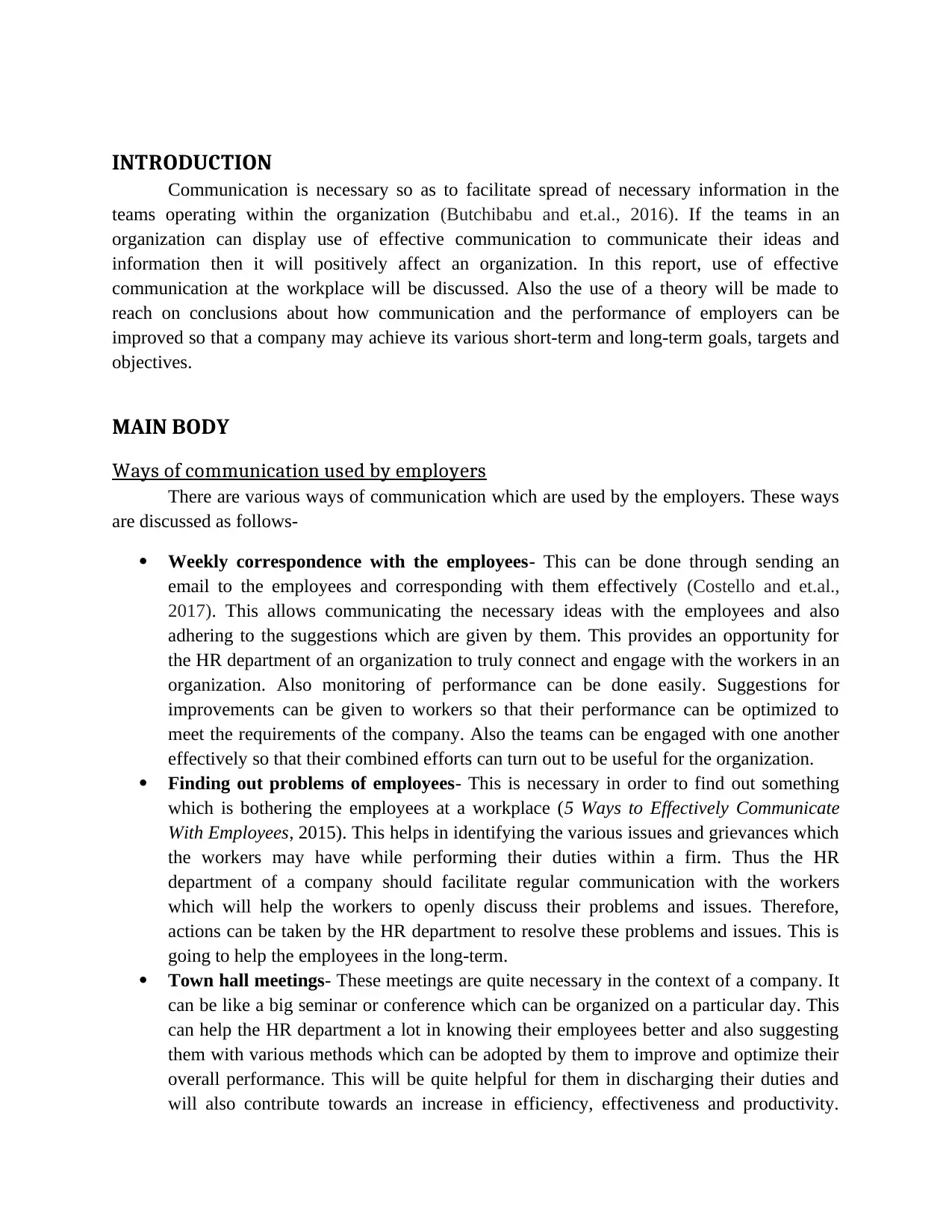
INTRODUCTION
Communication is necessary so as to facilitate spread of necessary information in the
teams operating within the organization (Butchibabu and et.al., 2016). If the teams in an
organization can display use of effective communication to communicate their ideas and
information then it will positively affect an organization. In this report, use of effective
communication at the workplace will be discussed. Also the use of a theory will be made to
reach on conclusions about how communication and the performance of employers can be
improved so that a company may achieve its various short-term and long-term goals, targets and
objectives.
MAIN BODY
Ways of communication used by employers
There are various ways of communication which are used by the employers. These ways
are discussed as follows-
Weekly correspondence with the employees- This can be done through sending an
email to the employees and corresponding with them effectively (Costello and et.al.,
2017). This allows communicating the necessary ideas with the employees and also
adhering to the suggestions which are given by them. This provides an opportunity for
the HR department of an organization to truly connect and engage with the workers in an
organization. Also monitoring of performance can be done easily. Suggestions for
improvements can be given to workers so that their performance can be optimized to
meet the requirements of the company. Also the teams can be engaged with one another
effectively so that their combined efforts can turn out to be useful for the organization.
Finding out problems of employees- This is necessary in order to find out something
which is bothering the employees at a workplace (5 Ways to Effectively Communicate
With Employees, 2015). This helps in identifying the various issues and grievances which
the workers may have while performing their duties within a firm. Thus the HR
department of a company should facilitate regular communication with the workers
which will help the workers to openly discuss their problems and issues. Therefore,
actions can be taken by the HR department to resolve these problems and issues. This is
going to help the employees in the long-term.
Town hall meetings- These meetings are quite necessary in the context of a company. It
can be like a big seminar or conference which can be organized on a particular day. This
can help the HR department a lot in knowing their employees better and also suggesting
them with various methods which can be adopted by them to improve and optimize their
overall performance. This will be quite helpful for them in discharging their duties and
will also contribute towards an increase in efficiency, effectiveness and productivity.
Communication is necessary so as to facilitate spread of necessary information in the
teams operating within the organization (Butchibabu and et.al., 2016). If the teams in an
organization can display use of effective communication to communicate their ideas and
information then it will positively affect an organization. In this report, use of effective
communication at the workplace will be discussed. Also the use of a theory will be made to
reach on conclusions about how communication and the performance of employers can be
improved so that a company may achieve its various short-term and long-term goals, targets and
objectives.
MAIN BODY
Ways of communication used by employers
There are various ways of communication which are used by the employers. These ways
are discussed as follows-
Weekly correspondence with the employees- This can be done through sending an
email to the employees and corresponding with them effectively (Costello and et.al.,
2017). This allows communicating the necessary ideas with the employees and also
adhering to the suggestions which are given by them. This provides an opportunity for
the HR department of an organization to truly connect and engage with the workers in an
organization. Also monitoring of performance can be done easily. Suggestions for
improvements can be given to workers so that their performance can be optimized to
meet the requirements of the company. Also the teams can be engaged with one another
effectively so that their combined efforts can turn out to be useful for the organization.
Finding out problems of employees- This is necessary in order to find out something
which is bothering the employees at a workplace (5 Ways to Effectively Communicate
With Employees, 2015). This helps in identifying the various issues and grievances which
the workers may have while performing their duties within a firm. Thus the HR
department of a company should facilitate regular communication with the workers
which will help the workers to openly discuss their problems and issues. Therefore,
actions can be taken by the HR department to resolve these problems and issues. This is
going to help the employees in the long-term.
Town hall meetings- These meetings are quite necessary in the context of a company. It
can be like a big seminar or conference which can be organized on a particular day. This
can help the HR department a lot in knowing their employees better and also suggesting
them with various methods which can be adopted by them to improve and optimize their
overall performance. This will be quite helpful for them in discharging their duties and
will also contribute towards an increase in efficiency, effectiveness and productivity.
⊘ This is a preview!⊘
Do you want full access?
Subscribe today to unlock all pages.

Trusted by 1+ million students worldwide
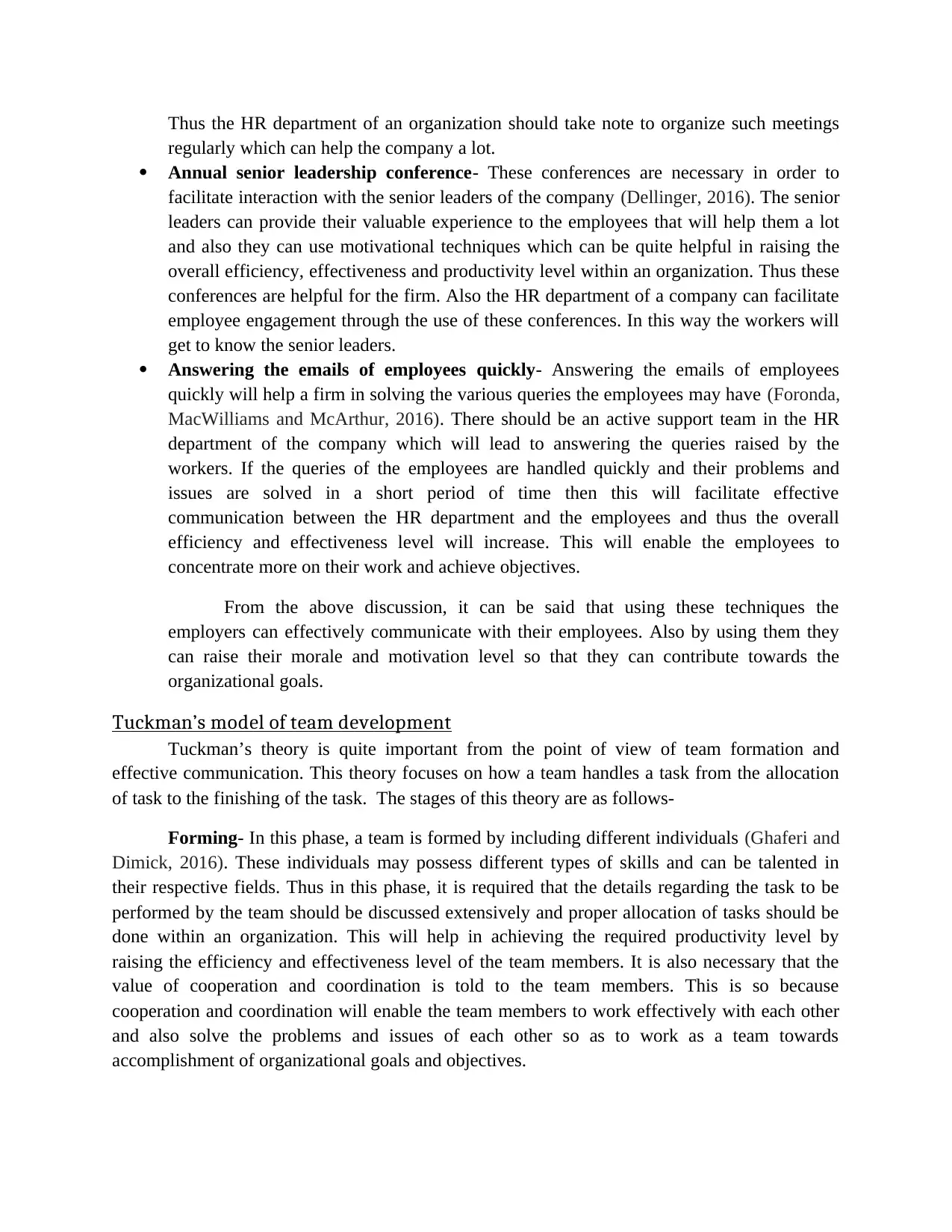
Thus the HR department of an organization should take note to organize such meetings
regularly which can help the company a lot.
Annual senior leadership conference- These conferences are necessary in order to
facilitate interaction with the senior leaders of the company (Dellinger, 2016). The senior
leaders can provide their valuable experience to the employees that will help them a lot
and also they can use motivational techniques which can be quite helpful in raising the
overall efficiency, effectiveness and productivity level within an organization. Thus these
conferences are helpful for the firm. Also the HR department of a company can facilitate
employee engagement through the use of these conferences. In this way the workers will
get to know the senior leaders.
Answering the emails of employees quickly- Answering the emails of employees
quickly will help a firm in solving the various queries the employees may have (Foronda,
MacWilliams and McArthur, 2016). There should be an active support team in the HR
department of the company which will lead to answering the queries raised by the
workers. If the queries of the employees are handled quickly and their problems and
issues are solved in a short period of time then this will facilitate effective
communication between the HR department and the employees and thus the overall
efficiency and effectiveness level will increase. This will enable the employees to
concentrate more on their work and achieve objectives.
From the above discussion, it can be said that using these techniques the
employers can effectively communicate with their employees. Also by using them they
can raise their morale and motivation level so that they can contribute towards the
organizational goals.
Tuckman’s model of team development
Tuckman’s theory is quite important from the point of view of team formation and
effective communication. This theory focuses on how a team handles a task from the allocation
of task to the finishing of the task. The stages of this theory are as follows-
Forming- In this phase, a team is formed by including different individuals (Ghaferi and
Dimick, 2016). These individuals may possess different types of skills and can be talented in
their respective fields. Thus in this phase, it is required that the details regarding the task to be
performed by the team should be discussed extensively and proper allocation of tasks should be
done within an organization. This will help in achieving the required productivity level by
raising the efficiency and effectiveness level of the team members. It is also necessary that the
value of cooperation and coordination is told to the team members. This is so because
cooperation and coordination will enable the team members to work effectively with each other
and also solve the problems and issues of each other so as to work as a team towards
accomplishment of organizational goals and objectives.
regularly which can help the company a lot.
Annual senior leadership conference- These conferences are necessary in order to
facilitate interaction with the senior leaders of the company (Dellinger, 2016). The senior
leaders can provide their valuable experience to the employees that will help them a lot
and also they can use motivational techniques which can be quite helpful in raising the
overall efficiency, effectiveness and productivity level within an organization. Thus these
conferences are helpful for the firm. Also the HR department of a company can facilitate
employee engagement through the use of these conferences. In this way the workers will
get to know the senior leaders.
Answering the emails of employees quickly- Answering the emails of employees
quickly will help a firm in solving the various queries the employees may have (Foronda,
MacWilliams and McArthur, 2016). There should be an active support team in the HR
department of the company which will lead to answering the queries raised by the
workers. If the queries of the employees are handled quickly and their problems and
issues are solved in a short period of time then this will facilitate effective
communication between the HR department and the employees and thus the overall
efficiency and effectiveness level will increase. This will enable the employees to
concentrate more on their work and achieve objectives.
From the above discussion, it can be said that using these techniques the
employers can effectively communicate with their employees. Also by using them they
can raise their morale and motivation level so that they can contribute towards the
organizational goals.
Tuckman’s model of team development
Tuckman’s theory is quite important from the point of view of team formation and
effective communication. This theory focuses on how a team handles a task from the allocation
of task to the finishing of the task. The stages of this theory are as follows-
Forming- In this phase, a team is formed by including different individuals (Ghaferi and
Dimick, 2016). These individuals may possess different types of skills and can be talented in
their respective fields. Thus in this phase, it is required that the details regarding the task to be
performed by the team should be discussed extensively and proper allocation of tasks should be
done within an organization. This will help in achieving the required productivity level by
raising the efficiency and effectiveness level of the team members. It is also necessary that the
value of cooperation and coordination is told to the team members. This is so because
cooperation and coordination will enable the team members to work effectively with each other
and also solve the problems and issues of each other so as to work as a team towards
accomplishment of organizational goals and objectives.
Paraphrase This Document
Need a fresh take? Get an instant paraphrase of this document with our AI Paraphraser
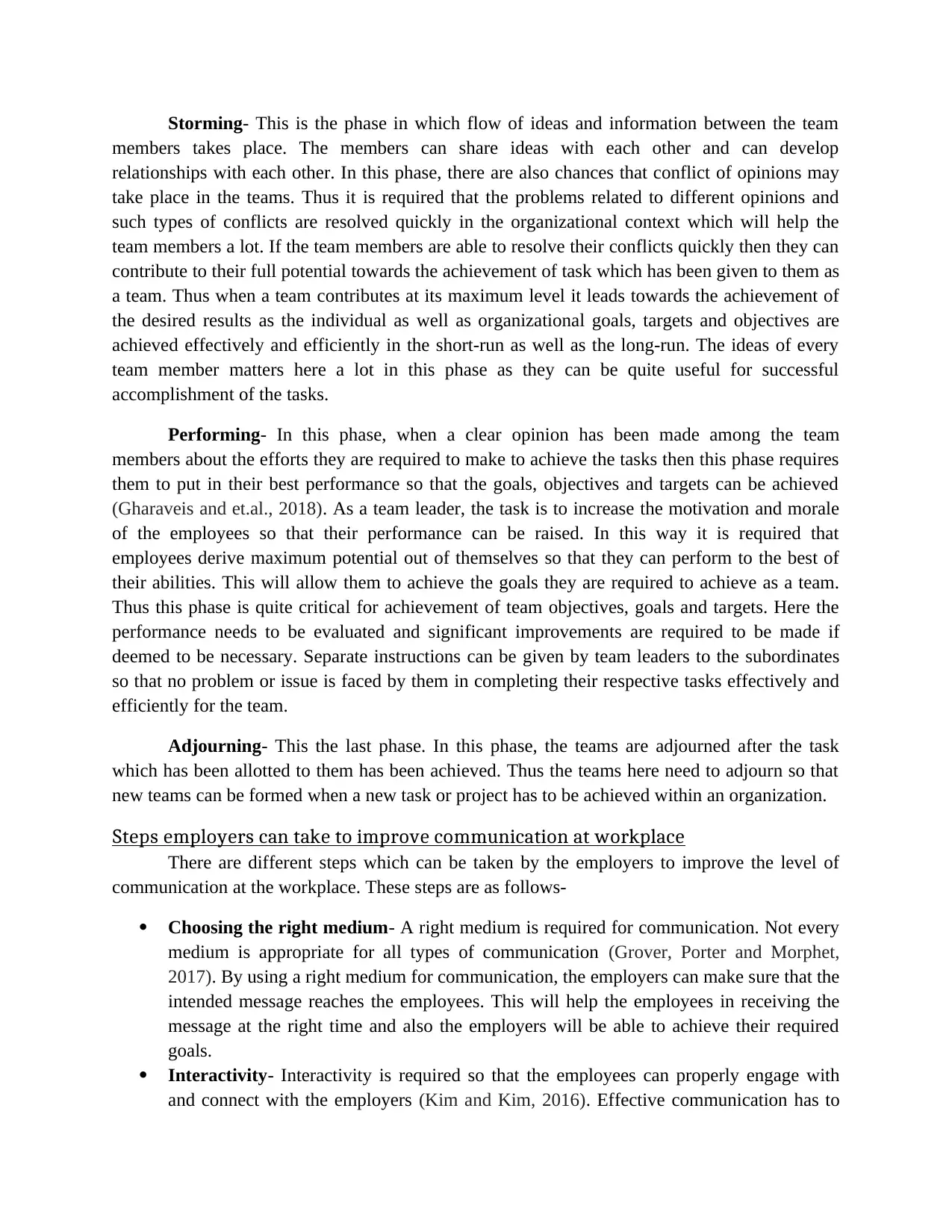
Storming- This is the phase in which flow of ideas and information between the team
members takes place. The members can share ideas with each other and can develop
relationships with each other. In this phase, there are also chances that conflict of opinions may
take place in the teams. Thus it is required that the problems related to different opinions and
such types of conflicts are resolved quickly in the organizational context which will help the
team members a lot. If the team members are able to resolve their conflicts quickly then they can
contribute to their full potential towards the achievement of task which has been given to them as
a team. Thus when a team contributes at its maximum level it leads towards the achievement of
the desired results as the individual as well as organizational goals, targets and objectives are
achieved effectively and efficiently in the short-run as well as the long-run. The ideas of every
team member matters here a lot in this phase as they can be quite useful for successful
accomplishment of the tasks.
Performing- In this phase, when a clear opinion has been made among the team
members about the efforts they are required to make to achieve the tasks then this phase requires
them to put in their best performance so that the goals, objectives and targets can be achieved
(Gharaveis and et.al., 2018). As a team leader, the task is to increase the motivation and morale
of the employees so that their performance can be raised. In this way it is required that
employees derive maximum potential out of themselves so that they can perform to the best of
their abilities. This will allow them to achieve the goals they are required to achieve as a team.
Thus this phase is quite critical for achievement of team objectives, goals and targets. Here the
performance needs to be evaluated and significant improvements are required to be made if
deemed to be necessary. Separate instructions can be given by team leaders to the subordinates
so that no problem or issue is faced by them in completing their respective tasks effectively and
efficiently for the team.
Adjourning- This the last phase. In this phase, the teams are adjourned after the task
which has been allotted to them has been achieved. Thus the teams here need to adjourn so that
new teams can be formed when a new task or project has to be achieved within an organization.
Steps employers can take to improve communication at workplace
There are different steps which can be taken by the employers to improve the level of
communication at the workplace. These steps are as follows-
Choosing the right medium- A right medium is required for communication. Not every
medium is appropriate for all types of communication (Grover, Porter and Morphet,
2017). By using a right medium for communication, the employers can make sure that the
intended message reaches the employees. This will help the employees in receiving the
message at the right time and also the employers will be able to achieve their required
goals.
Interactivity- Interactivity is required so that the employees can properly engage with
and connect with the employers (Kim and Kim, 2016). Effective communication has to
members takes place. The members can share ideas with each other and can develop
relationships with each other. In this phase, there are also chances that conflict of opinions may
take place in the teams. Thus it is required that the problems related to different opinions and
such types of conflicts are resolved quickly in the organizational context which will help the
team members a lot. If the team members are able to resolve their conflicts quickly then they can
contribute to their full potential towards the achievement of task which has been given to them as
a team. Thus when a team contributes at its maximum level it leads towards the achievement of
the desired results as the individual as well as organizational goals, targets and objectives are
achieved effectively and efficiently in the short-run as well as the long-run. The ideas of every
team member matters here a lot in this phase as they can be quite useful for successful
accomplishment of the tasks.
Performing- In this phase, when a clear opinion has been made among the team
members about the efforts they are required to make to achieve the tasks then this phase requires
them to put in their best performance so that the goals, objectives and targets can be achieved
(Gharaveis and et.al., 2018). As a team leader, the task is to increase the motivation and morale
of the employees so that their performance can be raised. In this way it is required that
employees derive maximum potential out of themselves so that they can perform to the best of
their abilities. This will allow them to achieve the goals they are required to achieve as a team.
Thus this phase is quite critical for achievement of team objectives, goals and targets. Here the
performance needs to be evaluated and significant improvements are required to be made if
deemed to be necessary. Separate instructions can be given by team leaders to the subordinates
so that no problem or issue is faced by them in completing their respective tasks effectively and
efficiently for the team.
Adjourning- This the last phase. In this phase, the teams are adjourned after the task
which has been allotted to them has been achieved. Thus the teams here need to adjourn so that
new teams can be formed when a new task or project has to be achieved within an organization.
Steps employers can take to improve communication at workplace
There are different steps which can be taken by the employers to improve the level of
communication at the workplace. These steps are as follows-
Choosing the right medium- A right medium is required for communication. Not every
medium is appropriate for all types of communication (Grover, Porter and Morphet,
2017). By using a right medium for communication, the employers can make sure that the
intended message reaches the employees. This will help the employees in receiving the
message at the right time and also the employers will be able to achieve their required
goals.
Interactivity- Interactivity is required so that the employees can properly engage with
and connect with the employers (Kim and Kim, 2016). Effective communication has to
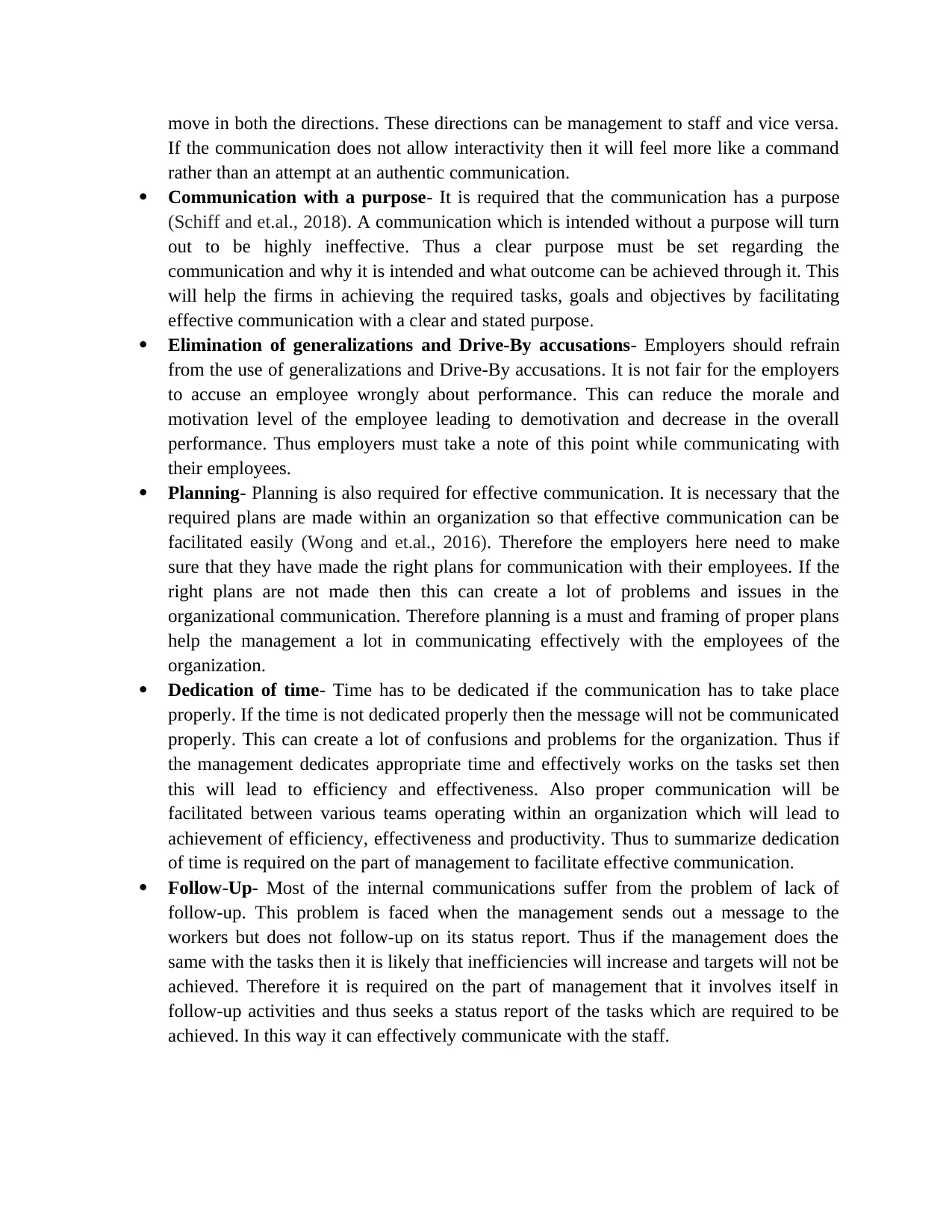
move in both the directions. These directions can be management to staff and vice versa.
If the communication does not allow interactivity then it will feel more like a command
rather than an attempt at an authentic communication.
Communication with a purpose- It is required that the communication has a purpose
(Schiff and et.al., 2018). A communication which is intended without a purpose will turn
out to be highly ineffective. Thus a clear purpose must be set regarding the
communication and why it is intended and what outcome can be achieved through it. This
will help the firms in achieving the required tasks, goals and objectives by facilitating
effective communication with a clear and stated purpose.
Elimination of generalizations and Drive-By accusations- Employers should refrain
from the use of generalizations and Drive-By accusations. It is not fair for the employers
to accuse an employee wrongly about performance. This can reduce the morale and
motivation level of the employee leading to demotivation and decrease in the overall
performance. Thus employers must take a note of this point while communicating with
their employees.
Planning- Planning is also required for effective communication. It is necessary that the
required plans are made within an organization so that effective communication can be
facilitated easily (Wong and et.al., 2016). Therefore the employers here need to make
sure that they have made the right plans for communication with their employees. If the
right plans are not made then this can create a lot of problems and issues in the
organizational communication. Therefore planning is a must and framing of proper plans
help the management a lot in communicating effectively with the employees of the
organization.
Dedication of time- Time has to be dedicated if the communication has to take place
properly. If the time is not dedicated properly then the message will not be communicated
properly. This can create a lot of confusions and problems for the organization. Thus if
the management dedicates appropriate time and effectively works on the tasks set then
this will lead to efficiency and effectiveness. Also proper communication will be
facilitated between various teams operating within an organization which will lead to
achievement of efficiency, effectiveness and productivity. Thus to summarize dedication
of time is required on the part of management to facilitate effective communication.
Follow-Up- Most of the internal communications suffer from the problem of lack of
follow-up. This problem is faced when the management sends out a message to the
workers but does not follow-up on its status report. Thus if the management does the
same with the tasks then it is likely that inefficiencies will increase and targets will not be
achieved. Therefore it is required on the part of management that it involves itself in
follow-up activities and thus seeks a status report of the tasks which are required to be
achieved. In this way it can effectively communicate with the staff.
If the communication does not allow interactivity then it will feel more like a command
rather than an attempt at an authentic communication.
Communication with a purpose- It is required that the communication has a purpose
(Schiff and et.al., 2018). A communication which is intended without a purpose will turn
out to be highly ineffective. Thus a clear purpose must be set regarding the
communication and why it is intended and what outcome can be achieved through it. This
will help the firms in achieving the required tasks, goals and objectives by facilitating
effective communication with a clear and stated purpose.
Elimination of generalizations and Drive-By accusations- Employers should refrain
from the use of generalizations and Drive-By accusations. It is not fair for the employers
to accuse an employee wrongly about performance. This can reduce the morale and
motivation level of the employee leading to demotivation and decrease in the overall
performance. Thus employers must take a note of this point while communicating with
their employees.
Planning- Planning is also required for effective communication. It is necessary that the
required plans are made within an organization so that effective communication can be
facilitated easily (Wong and et.al., 2016). Therefore the employers here need to make
sure that they have made the right plans for communication with their employees. If the
right plans are not made then this can create a lot of problems and issues in the
organizational communication. Therefore planning is a must and framing of proper plans
help the management a lot in communicating effectively with the employees of the
organization.
Dedication of time- Time has to be dedicated if the communication has to take place
properly. If the time is not dedicated properly then the message will not be communicated
properly. This can create a lot of confusions and problems for the organization. Thus if
the management dedicates appropriate time and effectively works on the tasks set then
this will lead to efficiency and effectiveness. Also proper communication will be
facilitated between various teams operating within an organization which will lead to
achievement of efficiency, effectiveness and productivity. Thus to summarize dedication
of time is required on the part of management to facilitate effective communication.
Follow-Up- Most of the internal communications suffer from the problem of lack of
follow-up. This problem is faced when the management sends out a message to the
workers but does not follow-up on its status report. Thus if the management does the
same with the tasks then it is likely that inefficiencies will increase and targets will not be
achieved. Therefore it is required on the part of management that it involves itself in
follow-up activities and thus seeks a status report of the tasks which are required to be
achieved. In this way it can effectively communicate with the staff.
⊘ This is a preview!⊘
Do you want full access?
Subscribe today to unlock all pages.

Trusted by 1+ million students worldwide
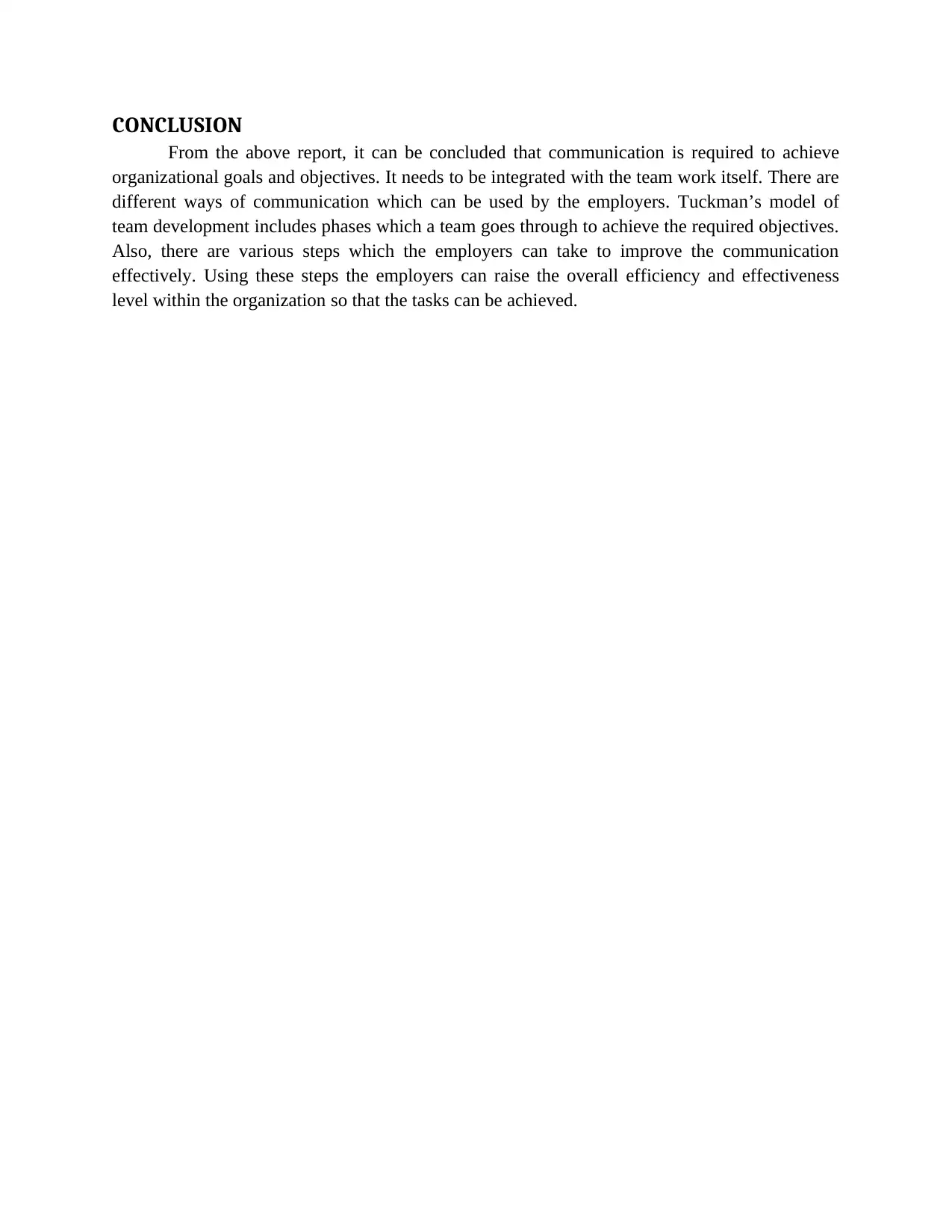
CONCLUSION
From the above report, it can be concluded that communication is required to achieve
organizational goals and objectives. It needs to be integrated with the team work itself. There are
different ways of communication which can be used by the employers. Tuckman’s model of
team development includes phases which a team goes through to achieve the required objectives.
Also, there are various steps which the employers can take to improve the communication
effectively. Using these steps the employers can raise the overall efficiency and effectiveness
level within the organization so that the tasks can be achieved.
From the above report, it can be concluded that communication is required to achieve
organizational goals and objectives. It needs to be integrated with the team work itself. There are
different ways of communication which can be used by the employers. Tuckman’s model of
team development includes phases which a team goes through to achieve the required objectives.
Also, there are various steps which the employers can take to improve the communication
effectively. Using these steps the employers can raise the overall efficiency and effectiveness
level within the organization so that the tasks can be achieved.
Paraphrase This Document
Need a fresh take? Get an instant paraphrase of this document with our AI Paraphraser
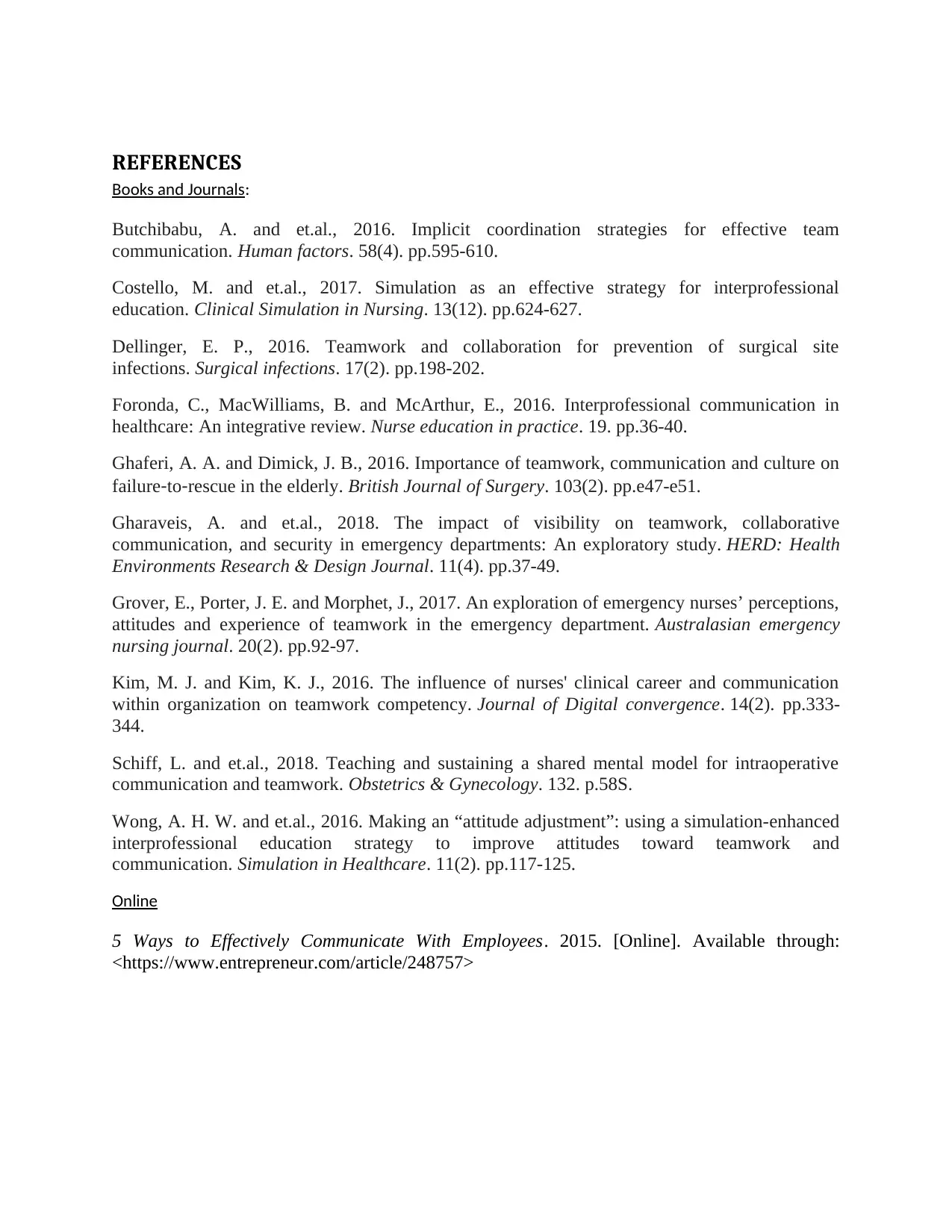
REFERENCES
Books and Journals:
Butchibabu, A. and et.al., 2016. Implicit coordination strategies for effective team
communication. Human factors. 58(4). pp.595-610.
Costello, M. and et.al., 2017. Simulation as an effective strategy for interprofessional
education. Clinical Simulation in Nursing. 13(12). pp.624-627.
Dellinger, E. P., 2016. Teamwork and collaboration for prevention of surgical site
infections. Surgical infections. 17(2). pp.198-202.
Foronda, C., MacWilliams, B. and McArthur, E., 2016. Interprofessional communication in
healthcare: An integrative review. Nurse education in practice. 19. pp.36-40.
Ghaferi, A. A. and Dimick, J. B., 2016. Importance of teamwork, communication and culture on
failure‐to‐rescue in the elderly. British Journal of Surgery. 103(2). pp.e47-e51.
Gharaveis, A. and et.al., 2018. The impact of visibility on teamwork, collaborative
communication, and security in emergency departments: An exploratory study. HERD: Health
Environments Research & Design Journal. 11(4). pp.37-49.
Grover, E., Porter, J. E. and Morphet, J., 2017. An exploration of emergency nurses’ perceptions,
attitudes and experience of teamwork in the emergency department. Australasian emergency
nursing journal. 20(2). pp.92-97.
Kim, M. J. and Kim, K. J., 2016. The influence of nurses' clinical career and communication
within organization on teamwork competency. Journal of Digital convergence. 14(2). pp.333-
344.
Schiff, L. and et.al., 2018. Teaching and sustaining a shared mental model for intraoperative
communication and teamwork. Obstetrics & Gynecology. 132. p.58S.
Wong, A. H. W. and et.al., 2016. Making an “attitude adjustment”: using a simulation-enhanced
interprofessional education strategy to improve attitudes toward teamwork and
communication. Simulation in Healthcare. 11(2). pp.117-125.
Online
5 Ways to Effectively Communicate With Employees. 2015. [Online]. Available through:
<https://www.entrepreneur.com/article/248757>
Books and Journals:
Butchibabu, A. and et.al., 2016. Implicit coordination strategies for effective team
communication. Human factors. 58(4). pp.595-610.
Costello, M. and et.al., 2017. Simulation as an effective strategy for interprofessional
education. Clinical Simulation in Nursing. 13(12). pp.624-627.
Dellinger, E. P., 2016. Teamwork and collaboration for prevention of surgical site
infections. Surgical infections. 17(2). pp.198-202.
Foronda, C., MacWilliams, B. and McArthur, E., 2016. Interprofessional communication in
healthcare: An integrative review. Nurse education in practice. 19. pp.36-40.
Ghaferi, A. A. and Dimick, J. B., 2016. Importance of teamwork, communication and culture on
failure‐to‐rescue in the elderly. British Journal of Surgery. 103(2). pp.e47-e51.
Gharaveis, A. and et.al., 2018. The impact of visibility on teamwork, collaborative
communication, and security in emergency departments: An exploratory study. HERD: Health
Environments Research & Design Journal. 11(4). pp.37-49.
Grover, E., Porter, J. E. and Morphet, J., 2017. An exploration of emergency nurses’ perceptions,
attitudes and experience of teamwork in the emergency department. Australasian emergency
nursing journal. 20(2). pp.92-97.
Kim, M. J. and Kim, K. J., 2016. The influence of nurses' clinical career and communication
within organization on teamwork competency. Journal of Digital convergence. 14(2). pp.333-
344.
Schiff, L. and et.al., 2018. Teaching and sustaining a shared mental model for intraoperative
communication and teamwork. Obstetrics & Gynecology. 132. p.58S.
Wong, A. H. W. and et.al., 2016. Making an “attitude adjustment”: using a simulation-enhanced
interprofessional education strategy to improve attitudes toward teamwork and
communication. Simulation in Healthcare. 11(2). pp.117-125.
Online
5 Ways to Effectively Communicate With Employees. 2015. [Online]. Available through:
<https://www.entrepreneur.com/article/248757>
1 out of 8
Related Documents
Your All-in-One AI-Powered Toolkit for Academic Success.
+13062052269
info@desklib.com
Available 24*7 on WhatsApp / Email
![[object Object]](/_next/static/media/star-bottom.7253800d.svg)
Unlock your academic potential
Copyright © 2020–2025 A2Z Services. All Rights Reserved. Developed and managed by ZUCOL.




